I'm out on the headland at Kilcummin, in north Co Mayo, looking for art. It's a bright, cold winter's day, and signage has guided me through the tiny village and out to this glorious spot. I'm on the hunt for Alan Counihan's Tearmann na Gaoithe, a stone-built window, giving a vista out to sea. I may have taken a wrong turn, as there's no sign of the sculpture, but I'm reminded of Richard Long's practice of turning his walks into art. Maybe here, too, the walk is the thing. There's a long golden beach to my left, and rolling fields falling to a rocky shore on my right. Do you need art in a location so beautiful? Maybe not, but I wouldn't be here if it wasn't for the promise of it.
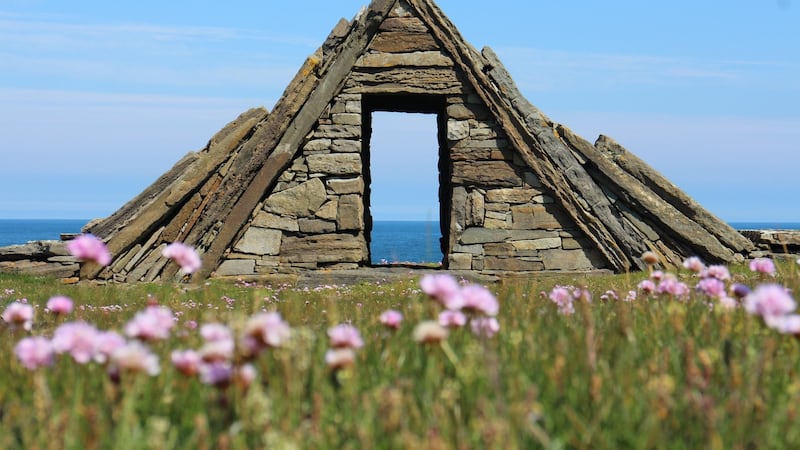
Tearmann na Gaoithe is part of Tír Sáile, the largest public arts trail put together in Ireland. It originated in 1993, to coincide with the opening of the Céide Fields visitors' centre, and the Mayo 5000 celebrations. Originally there were 14 site-specific art installations, although today just 11 remain. Part of the purpose of Tír Sáile was to bring people to this part of Ireland, and give them a reason to explore.
I head further up the coast to Downpatrick Head. Beyond the village of Ballycastle, known for the Ballinglen Arts Foundation, which offers residencies throughout the year, the headland is unmissable. Rising 40m above the sea, and giving views across the Atlantic to the Staggs islands and the awe-inspiring Dún Briste sea stack, the head is a signature discovery point on the Wild Atlantic Way.
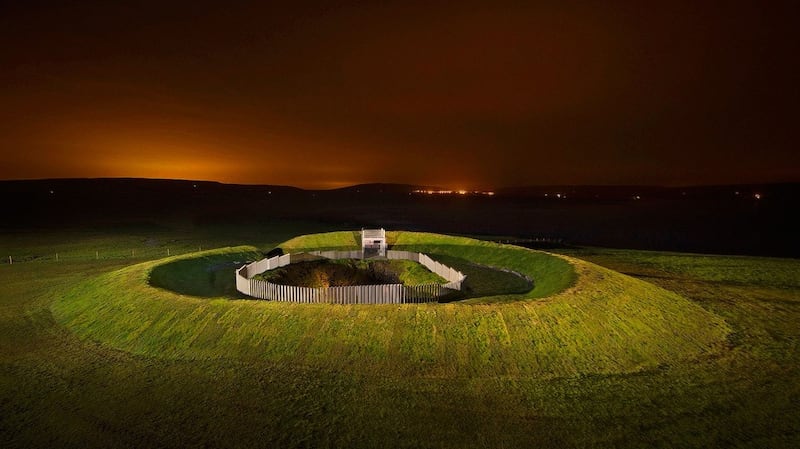
It's also home to a rather enormous installation. The Crossing consists of a mound of earth (think of an ancient ring fort), into which an enclosed structure is tucked, plus a metal paling fence, all surrounding a blowhole. It is one of eight Spirit of Place projects installed by US architect Travis Price and his students from his Spirit of Place, Spirit of Design course at the Catholic University of America. Of the eight, The Crossing is the largest and most costly. It was supported by the university and Mayo County Council, and by a €640,000 grant from Fáilte Ireland, part of the overall €10 million invested in the Wild Atlantic Way initiative in 2014.
The Wild Atlantic Way has been an exceptional success. A judicious combination of discovery points, signage and support has added to the attractions of the natural beauty of the west coast. Chapter four of Heinrich Böll's 1957 Irish Journal (the date refers to the German publication), was entitled "Mayo – God Help Us", due to Böll's awareness of people muttering "God help us" whenever the county was mentioned. But, like most newcomers, the Nobel laureate quickly fell for the charms of this often-neglected county. He took up residence in a cottage on Achill, which is now preserved for artists' and writers' residencies (heinrichboellcottage.com).
Fall in love
The problem is that, as with Böll’s experience, people tend to fall in love with Mayo only when they get there, so how do you get them there in the first place?
Tír Sáile was created to answer that question through art, and Spirit of Place is the next chapter in the story. So how did it come about that an American architect and his students are creating sculptures across the county? What has the feedback been like, and do the art works succeed in what Price describes as storytelling through architecture?
The story of Spirit of Place starts when Price was on a family holiday in Ireland. A friend suggested Mayo, "and so I stumbled in, and never stumbled out," he says. He discovered the Tír Sáile trail, and was introduced to Peter Hynes, who was then working for the county council on infrastructure. Hynes is now the county chief executive. "It was just a glorious visit," Price recalls. "Conversations started and we all hit it off so beautifully. We shook hands, and went on our way . . . Kind of like two cowboys riding off into the sunset." The first work, Thin Places, was built at Anagh Head in 2002.
Price is an engaging speaker, dropping tantalising nuggets into his conversation, such as his invitation from the Dalai Lama to make work at Dharamshala, his lectures for National Geographic, and a forthcoming Spirit of Place project at Cawdor Castle in Scotland – "from Shakespeare," he adds. In fact, Spirit of Place projects extend around the world, including Nepal, Peru, Italy and Finland as well as Ireland and the US. "It's kind of like an Indiana Jones map," says Price, enthusiastically. "It does wrap the entire globe. We're expanding it to other universities, I sort of see it as cultural literacy for architects."
The students, he tells me, approach each site through intensive research into the stories, histories and myths. They write poetry, before distilling their ideas into sculpture and thence to architecture.
“We work so hard getting into the deep story, the subconscious of it, it resonates. It’s very Socratic,” says Price of the process. “I’m a midwife, helping the baby come out. Probably the father as well,” he adds.
There’s definitely an authorial hand to the work. A fondness for cut stone, glass and metal rods predominates. Up at Downpatrick Head, I’m finding it difficult to wrap my head around it.
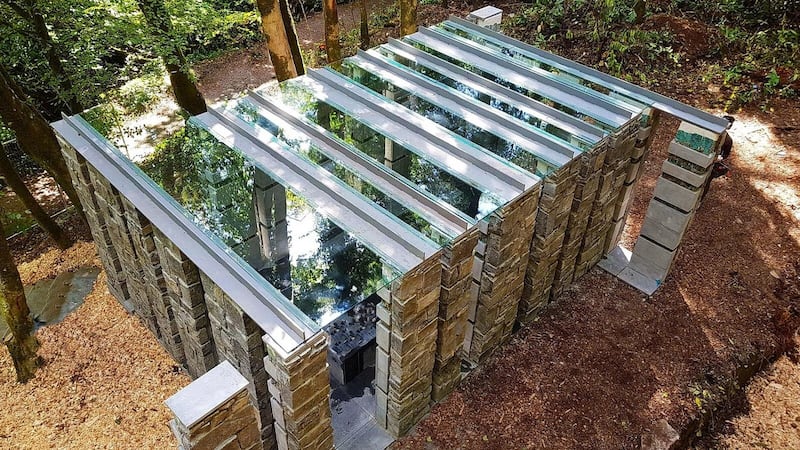
The blowhole had been the site of a series of tragedies, and had been surrounded for safety purposes by an ugly chain-link fence. When I ask in the locality about The Crossing, the uniform response is "it's needed for safety".
It’s not as if the headland was an unspoiled paradise prior to its installation either. There’s also a large statue of Saint Patrick and a concrete box hut that could either be to do with defence or sheep, I can’t be sure.
"The Crossing evokes the struggle and the sublime slipstream between the mystical and the material, the crossing between cultural history and the eternal sacred," reads the text on the northmayoarttrail.com website, which also includes a Tír Sáile map), which makes me question the poetry in which its design is rooted.
“It’s a premier question wherever we go,” says Price, when I ask him if public art in areas of natural beauty might not spoil, rather than enhance the experience. “You can have the modern view that nature is beautiful and handsome, and people mess it up. You can also have the other view, that while people need nature, nature needs people. It’s often said: The sunset is not aware of itself. There’s a moment when the human story, the metaphysical side, and the natural story coincide,” he says.
Truly magnificent
I drive on to Benwee Head, where the landscape is truly magnificent, with dramatic cliff edges, a sheltered cove and the sea thundering below. Here, A Home for the Children of Lir feels superfluous, though no more incongruous than the large red "No Dumping" sign at the pivotal point in the vista.
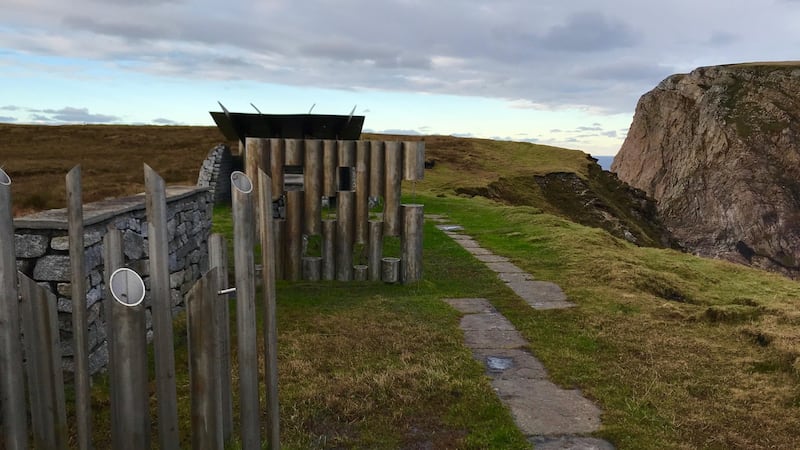
“The structure echoes Fionnuala, whose outstretched wings cradle three benches. ‘Finally there, they are home, under protected sister’s wings, resting peacefully,’” reads the text. I can’t help thinking that Price and his students have firmly located Ireland in a mythic poetic realm, shaping their experiences when here to fit, and while the language is undoubtedly floral, I’m not finding it made physical in the metal tubing and spiked roof of the structure.
Still, once again, however, I realise that I wouldn’t be here if it wasn’t for the art. “It’s a beginner’s step,” says Price, “not to disturb the landscape with some kind of crass high-rise tower, but it’s another to marry the landscape with a human story, and they’re kind of inseparable for me.”
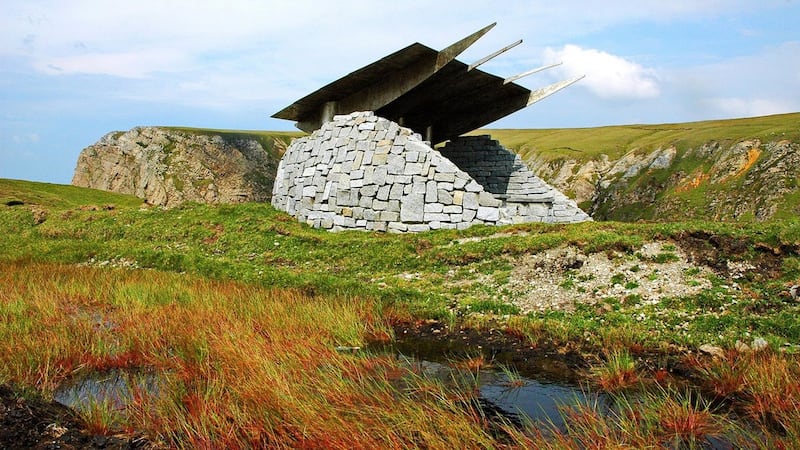
Artist Dorothy Cross disagrees with Price's take on placemaking. "My first encounter with one of these structures was while walking on the wilder side of Inishturk," she says. The work is entitled Tale of the Tongs, and "represents centuries of cultural gathering on Inishturk as a shrine, a respite, a viewing and resting point. It is a spiritual and cultural focus point representing the global Irish diaspora."
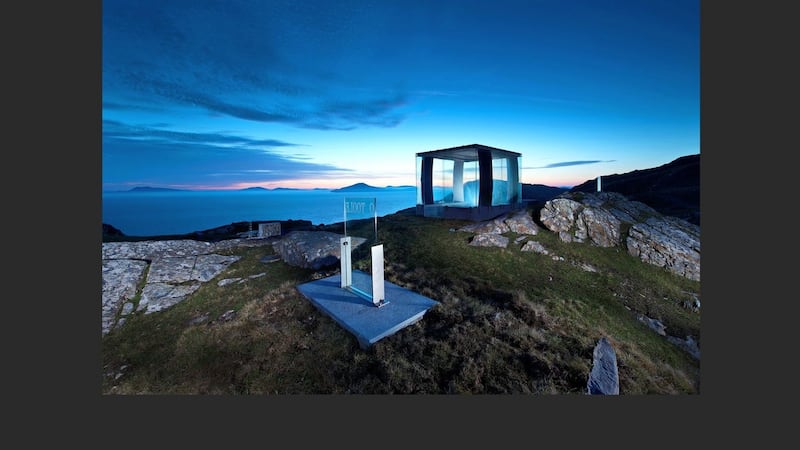
“I was shocked and saddened to come across what appeared to be a bus shelter on one of the most beautiful cliff walks in Ireland,” says Cross. “On research I learned that there were many more of these structures scattered across north Mayo. What was puzzling and shocking was why they are not known and spoken about. Surely, if successful, these works would have entered our visual landscape and conversation?
“There is a great difference between producing artwork for the confines of museum and gallery walls, where the page is blank and the works are transient, to art being placed permanently in places of natural beauty.
“Art placed in nature requires more consideration and sensitivity – a homage to the greater force of nature. There is a strong argument that we should consider non-permanence more often.”
This is an approach frequently taken by Mayo County Council arts office, which is separate from the Spirit of Place programme. Public art co-ordinator Gaynor Seville notes that upkeep and maintenance are also an issue with permanent works. More ephemeral pieces commissioned by the arts office include Aideen Barry's brilliant Strange Terrain, which was part of the Changing Tracks project on the Mayo Greenway in 2014.
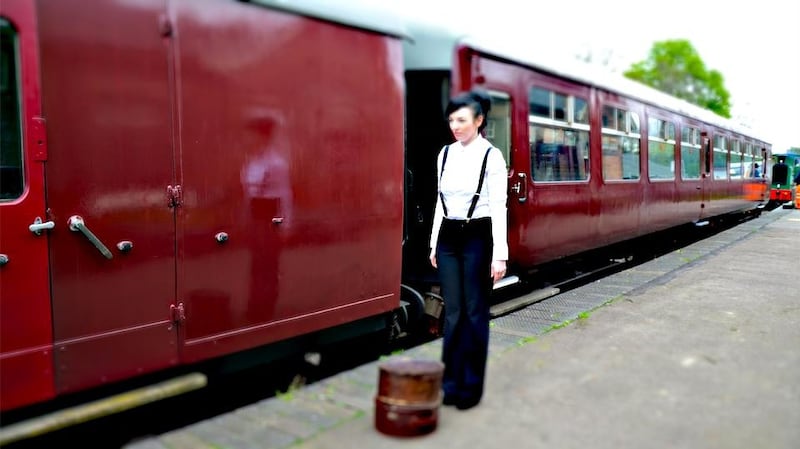
Back at my hotel in Ballina, I meet a couple who have just returned for a hunt for sites associated with General Humbert, who led the French forces in these parts in 1798.
Council objections
"Do you know about the Newgrange thing on the headland?" they ask, bemused. I refrain from directing them to Achill, where developer Joe McNamara's concrete Achill Henge (2011) still stands, despite council objections. McNamara described the structure, through his solicitor, as "a place of reflection," arguing that it was exempted from requirements for planning permission.
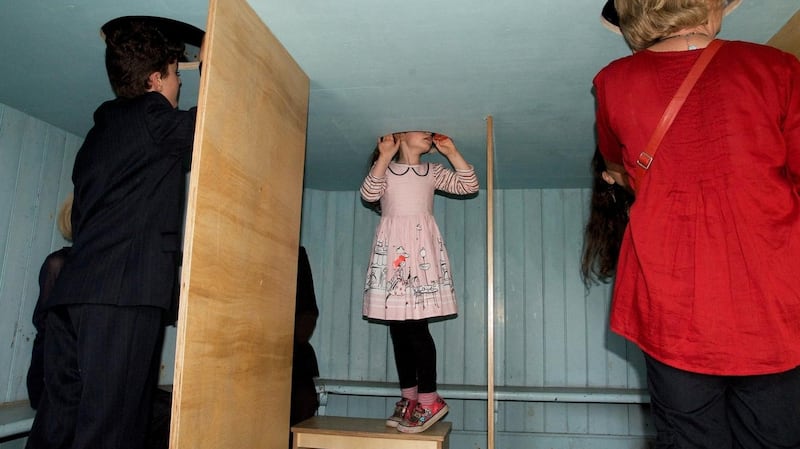
The Spirit of Place installations are also exempt from planning permission, as Hynes tells me. “We do the projects ourselves, so they’re not subject to planning permission. They’re not development in the sense of building, they don’t have any light pollution issues and they have a light footprint in terms of access.”
They are, however, permanent. The projects are funded by a combination of local authority funds, local sponsorship and a hefty contribution from the university and students.
“We think it’s valuable,” he says. “it’s not just art for art’s sake, it’s a springboard for revival. It’s all part of the effort to rebrand the county as a can-do county, an adventurous place, as a county that takes some risks.”
When I ask him whether other artists aren’t agitating for their own projects to get the support that Spirit of Place, with budgets ranging from €60,000 to €100,000, enjoys, he points out the support that Price himself brings. “It’s a package. They put resources into the design, they pay for their own transport and their own accommodation,” says Hynes. “And if anyone else wanted to do that, we’d be willing to talk to them.”
Bypassing the usual committee approach to selecting public art, which can lead to dull compromise, has enabled extremely distinctive works to be built across Mayo.
“Art by its nature instils a variety of responses and that is part of its power,” says Cross. “As viewers and/or artists, we have a giant responsibility. I believe there is a lot of fear around owning our own responses and a tendency to silence ourselves when it comes to art.”
Hynes and Price are planning a major conference on placemaking in Mayo in 2019. Let the conversation begin.
Mayo Art Trail: discover natural beauty with art along the way
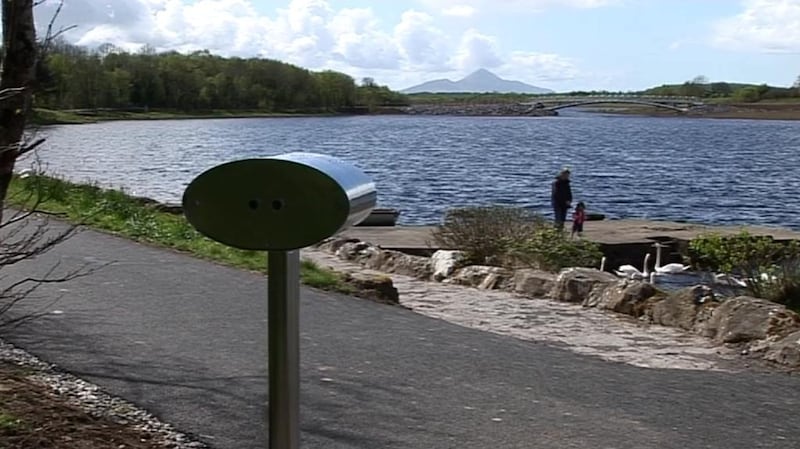
Procession of Souls – Spirit of Place, Swinford: This walled walkway to an old famine graveyard is a more gentle intervention.
Battling Forces – Tír Sáile: Fritze Rind's stone face-off between man and nature (a built wall abutting a pile of rock) at the foot of Downpatrick Head is a quiet moment in the natural drama.
On Sight: Cleary Connolly's four stereoscopes positioned along the shores of Lough Lannagh show brilliant alternative realities on the life of the lake.
The Thin Places – Spirit of Place, Annagh Head: "One sits there meditating while being shot through rusted steel frames out to the sea," reads the text, though there is no real danger of gunfire in this metal and stone construction.
The Fishers of Men – Spirit of Place, Cong: The most recent in the series, this shelter echoes that on Inishturk, and celebrates "the Gospel of Matthew in concert with the mysterious sun boat god, Manannán Mac Lir, who commands the boat passages between the sun and the underwater voyages into the underworld". Tread carefully.




















